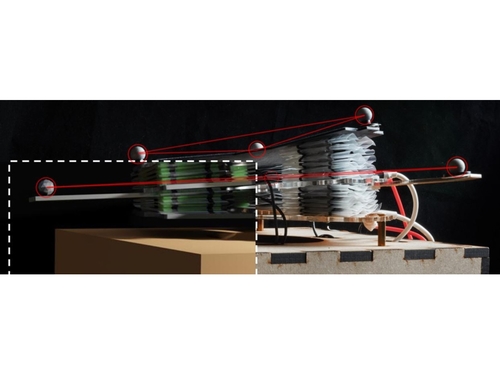2022
Hainsworth, T., Schmidt, I., Sundaram, V., Whiting, G. L., Keplinger, C., MacCurdy, R.
Simulating Electrohydraulic Soft Actuator Assemblies Via Reduced Order Modeling
SOFT ROBOTICS. IEEE INTERNATIONAL CONFERENCE. 5TH 2022. (RoboSoft 2022), pages: 21-28, Institute of Electrical and Electronics Engineers (IEEE), 2022 IEEE 5th International Conference on Soft Robotics (RoboSoft), April 2022 (conference)
2021
Purnendu, , Novack, S., Acome, E., Alistar, M., Keplinger, C., Gross, M. D., Bruns, C., Leithinger, D.
Electriflow: Augmenting Books With Tangible Animation Using Soft Electrohydraulic Actuators
In SIGGRAPH ’21: ACM SIGGRAPH 2021 Labs, pages: 8, ACM, New York, NY, Special Interest Group on Computer Graphics and Interactive Techniques Conference (SIGGRAPH 2021), July 2021 (inproceedings)
Purnendu, , Novack, S. M., Acome, E., Keplinger, C., Alistar, M., Gross, M. D., Bruns, C., Leithinger, D.
Electriflow: Soft Electrohydraulic Building Blocks for Prototyping Shape-changing Interfaces
In DIS ’21: Designing Interactive Systems Conference 2021, pages: 1280-1290, ACM, New York, NY, Designing Interactive Systems Conference (DIS 2021), June 2021 (inproceedings)
Purnendu, , Acome, E., Keplinger, C., Gross, M. D., Bruns, C., Leithinger, D.
Soft Electrohydraulic Actuators for Origami Inspired Shape-Changing Interfaces
In CHI EA ’21: Extended Abstracts of the 2021 CHI Conference on Human Factors in Computing Systems, pages: 377, ACM, New York, NY, Conference on Human Factors in Computing Systems (CHI 2021), May 2021 (inproceedings)
2019
McMahon, J., Mitchell, S. K., Oguri, K., Kellaris, N., Kuettel, D., Keplinger, C., Bercovici, B.
Area-of-effect softbots (aoes) for asteroid proximity operations
In 2019 IEEE Aerospace Conference (AERO 2019), pages: 1554-1569, IEEE, Piscataway, NJ, IEEE Aerospace Conference (AERO 2019), 2019 (inproceedings)
2018
Schunk, C., Pearson, L., Acome, E., Morrissey, T. G., Correll, N., Keplinger, C., Rentschler, M. E., Humbert, J. S.
System identification and closed-loop control of a hydraulically amplified self-healing electrostatic (HASEL) actuator
In 2018 IEEE/RSJ International Conference on Intelligent Robots and Systems (IROS 2018), pages: 6417-6423, IEEE, Piscataway, NJ, IEEE/RSJ International Conference on Intelligent Robots and Systems (IROS 2018), October 2018 (inproceedings)
2012
Li, T., Qu, S., Keplinger, C., Kaltseis, R., Baumgartner, R., Bauer, S., Suo, Z., Yang, W.
Modeling Guided Design of Dielectric Elastomer Generators and Actuators
In Proceedings of the SPIE 8340, Electroactive Polymer Actuators and Devices conference, pages: 83401X, April 2012 (inproceedings)
Li, T., Qu, S., Keplinger, C., Suo, Z., Yang, W.
Inhomogeneous Deformation and Instability in Soft Dielectric Transducers
In Proceedings of the APS March Meeting 2012, 57(1), Boston, USA, March 2012 (inproceedings)
2011
Baumgartner, R., Keplinger, C., Kaltseis, R., Schwödiauer, R., Bauer, S.
Dielectric Elastomers: From the Beginning of Modern Science to Applications in Actuators and Energy Harvesters
In Proceedings of the SPIE Smart Structures and Materials + Nondestructive Evaluation and Health Monitoring conference, San Diego, USA, 2011 (inproceedings)
2010
Li, T., Keplinger, C., Liu, L., Baumgartner, R., Qu, S.
Modeling of Inhomogeneous Deformation in a Dielectric Elastomer Generator for Energy Harvesting
In Proceedings of the ASME 2010 Conference on Smart Materials, Adaptive Structures and Intelligent Systems, pages: 267, Philadelphia, USA, September 2010 (inproceedings)
2008
Kaltenbrunner, M., Keplinger, C., Arnold, N., Bauer, S.
Analysis of Safe and Failure Mode Regimes of Dielectric Elastomer Actuators
In Proceedings of the IEEE SENSORS 2008 Conference, pages: 156-159, Lecce, Italy, October 2008 (inproceedings)
Schwodiauer, R., Graz, I., Kaltenbrunner, M., Keplinger, C., Bartu, P., Buchberger, G., Ortwein, C., Bauer, S.
Cellular Ferroelectrets for Soft Matter Integrated Devices with Advanced Functionality
In Proceedings of the 13th International Symposium on Electrets, Tokyo, Japan, September 2008 (inproceedings)
Schwödiauer, R., Graz, I., Kaltenbrunner, M., Keplinger, C., Bartu, P., Buchberger, G., Ortwein, C., Bauer, S.
Cellular Ferroelectrets for Electroactive Polymer Hybrid Systems: Soft Matter Integrated Devices with Advanced Functionality
In Proceedings of the SPIE Vol. 6927 , pages: 69270Q 1-10, San Diego, USA, April 2008 (inproceedings)
2005
Bauer, S., Bauer-Gogonea, S., Dansachmüller, M., Dennler, G., Graz, I., Kaltenbrunner, M., Keplinger, C., Reiss, H., Sariciftci, N. S., Singh, T. B., Schwödiauer, R.
Piezoelectric Polymers
In Proceedings of the Symposium W – Electroresponsive Polymers and Their Applications , 889, pages: 0889-W01-02, 2005 (inproceedings)


